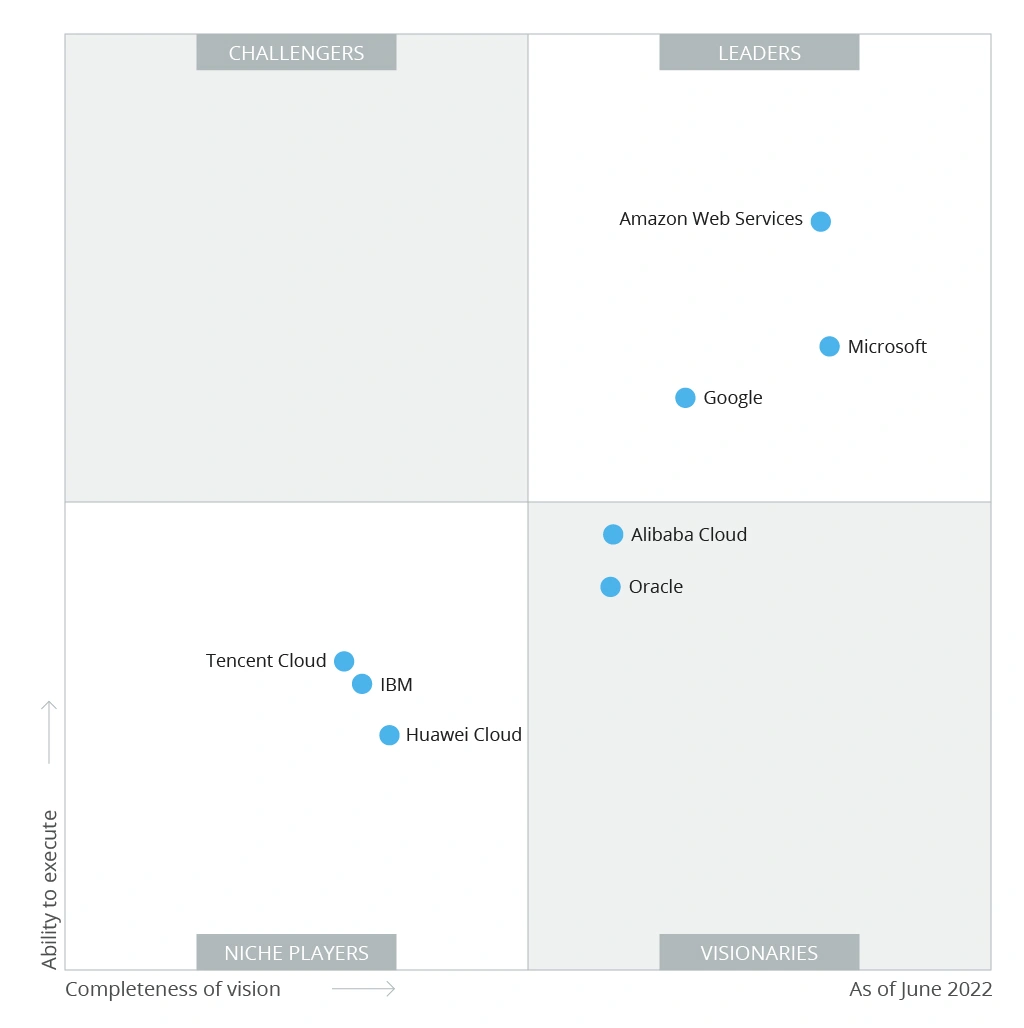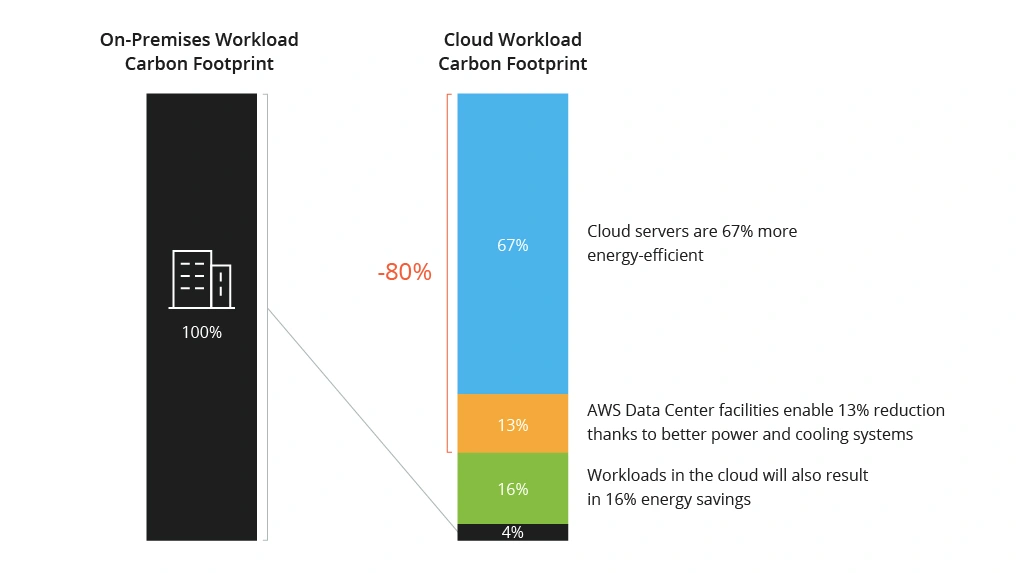AWS Migration Strategy: From On-premises to AWS Public Cloud
As your company grows, so do your business processes and data volumes. If you want to effectively manage all these workflows, capitalize on the benefits that cloud environments provide.
Here are some stats to help make up your mind. Currently, 90% of worldwide enterprises implement a multi-cloud infrastructure, with 60% of the world’s corporate data being stored in the cloud. Moreover, the cloud application market is estimated to be worth more than $150 billion, and this number is projected to reach $168.6 billion by 2025.
The reason for moving to cloud environments is clearly evident, but what about the cloud type? In the beginning, a private cloud might be enough for accomplishing your goals, but if you plan to expand your business, you will certainly need more resources. And public cloud providers can give you those resources.
As experts in all things cloud, we suggest an Amazon Web Services (AWS) cloud migration approach. Why AWS? Read on to find out.
Six Reasons to Migrate to AWS
Market Leader
AWS is the absolute leader among cloud infrastructure and platform services providers, with an availability of 76 locations in 24 regions.
From moving separate workloads to entire data centers, AWS has helped organizations of all sizes and from different niches to solve their data-related tasks. For now, the company has over a million active customers, including brands like Ferrari, NASA, Snapchat, and Formula 1.
Such massive popularity directly correlates to user satisfaction: AWS enables clients to be better positioned to reduce infrastructure costs, enhance administrator productivity, accelerate time to market, and drive innovation — all while ensuring utmost security.
Broad Scope of Services
AWS offers more than 200 options for different use cases, so you will have the possibility to effectively manage a large variety of business-specific tasks.
From cloud storage and serverless computing to automation and ML-based analysis, Amazon’s platform is ready to assist you.
Cost Savings
By migrating your infrastructure to AWS, you can save at least 20% in total infrastructure costs. According to the respondents surveyed, this equals approximately to $69 million — out of $345 million in pre-migration annual IT spend.
Better Efficiency
Besides getting substantial cost savings, you can also increase developer productivity through AWS code automation tools. This will help you accelerate time to release for migrated applications by an average of 32%.
Uptime
Downtime is one of the greatest concerns when migrating data to the cloud. Conversely, AWS offers business continuity in this regard: 99.99% uptime, 69% decrease in unplanned downtime, and 45% fewer security-related accidents.
Sustainability and Energy Efficiency
Another key AWS advantage is sustainability. To wit, Amazon's cloud platform is up to five times more energy-efficient than similar data centers. And this also means reduced carbon emissions and lower energy bills.
How to Migrate to AWS: Three Steps
If after considering all the benefits of AWS migration you have decided to act, here are the key steps to take:
1. Assess Application Readiness
Gauge the applications’ constraints in terms of security and data sovereignty, hardware limitations, operating system compatibility, data storage, and network connectivity.
Such an assessment is a time-consuming and error-prone process, so think about automating it. When this preliminary stage is complete, prepare an action plan and proceed to its implementation.
A case in point: Infopulse worked with a client to assess their cloud readiness, create a cost-efficient cloud migration plan, and perform the full-scale infrastructure migration to the cloud. By ensuring seamless 24/7 AWS operations service and quick response times, Infopulse provided 99.9% infrastructure availability.
2. Choose the Optimal Migration Scenario
To successfully perform the migration, you should opt for the optimal strategy — depending on your applications, resource availability, and business specifics. Here are some options for you to consider.
- Retain. If you have some obsolete applications, for example, those with unresolved non-x86 dependencies, it is better to retain them — in other words, leave them in place and revisit later. By migrating only those applications that impose great value to your business, you will also optimize the migration costs.
- Retire. When it comes to legacy software that is no longer useful to your business, do not lose time and money trying to adjust it. Replace the software with alternative, cloud-based SaaS tools.
- Rehost. Workable applications that have great value for your business can be migrated from on-premise hardware to the AWS cloud with no changes to the key components like code and database.
- Replatform. This scenario is perfect for applications that need slight changes before being migrated. Configuration adjustments, and version upgrades — these changes will help adapt your software to a new architecture platform on the AWS cloud.
- Refactor/re-architect. Once you determine that any of your value-rich applications are not compatible with the AWS cloud, you might need to rebuild them with a new code base, i.e. add new features, enhance performance or scalability. However, keep in mind that such significant changes might affect the overall enterprise ecosystem performance.
3. Implement the Best Tech
If you want the migration process to go off without a hitch, employ AWS native tools. They will help you simplify, automate, and accelerate the whole process.
Migration Evaluator
This AWS tool makes the best of predictive analytics to provide data-driven insights into every step of your cloud migration journey. With this mechanism in place, you can make sure you run your applications at the right place and at the lowest TCO — despite environment, cloud, or price options changes.
AWS Migration Hub
By leveraging this cutting-edge tool, you will always be in the loop about the progress of the whole migration process, including assessment, planning, and implementation.
What AWS mechanisms and third-party tools to employ, how to use key metrics for analyzing every particular application, how to speed up implementation through automation — AWS Migration Hub delivers this and more.
AWS Application Discovery Service
With AWS Application Discovery Service, you will easily collect all the real-time information about your on-premises inventory, including aspects like usage, configuration, and behavior data.
Underpinned by this knowledge, you will enable effective asset management in your AWS environment. Namely, you’ll better understand your workloads and all possible application dependencies — to establish move groups, adjust your migration strategy, and prepare for the very migration.
Migration Partner Solutions
To speed up the migration process without sacrificing quality, combine AWS tools with Amazon partner solutions and third-party expertise that you can get from a cloud migration services provider like Infopulse. This way, you will get impeccable know-how and the mechanisms necessary for your tailored migration strategy.
Infopulse is a multi-year AWS partner that offers a wide range of services to drive your growth. From comprehensive architecture consulting and DevOps implementation to custom solution re-architecting and full-scale cloud migration, Infopulse’s AWS Center of Excellence is ready to address the most daunting and specific business challenges.
AWS Landing Zone
This tool is a must for establishing an initial security and compliance foundation for your multi-account cloud environment.
In combination with third-party solutions, AWS Landing Zone will help you to enable the consistency of all operations across regions and industries, prepare applications for your cloud compliance program, and deploy a centrally managed encryption strategy.
AWS Management and Governance
Another rock-solid AWS tool, AWS Management and Governance is geared to give you more innovation and control. This mechanism can help you govern and effectively deal with highly dynamic AWS and hybrid cloud resources at scale, while decreasing complexity and slashing costs.
AWS Marketplace
Amazon offers a broad digital catalog of infrastructure and modernization solutions from independent software vendors. By choosing the one best suited for your company’s needs, you’ll accelerate your digital transformation — and avoid over-purchasing with unnecessary or even questionable tools.
On a Final Note
As we have covered in this article, successful AWS migration comes with many benefits. The process, however, is not necessarily easy to execute. Moreover, AWS tools on their own are not always enough to achieve specific technical and business goals.
A reliable Amazon partner, Infopulse has the right expertise and skills to assist you at every step of the full-fledged cloud migration — from business case analysis and creation of an AWS migration strategy to implementation and support.
![AWS migration strategy [banner]](https://www.infopulse.com/uploads/media/banner-1920x528-aws-migration-strategy.webp)




![Cloud-Native for Banking [thumbnail]](/uploads/media/cloud-native-solutions-for-banking_280x222.webp)
![Generative AI and Power BI [thumbnail]](/uploads/media/thumbnail-280x222-generative-AI-and-Power-BI-a-powerful.webp)
![Cloud Native vs. Cloud Agnostic [thumbnail]](/uploads/media/thumbnail-280x222-cloud-agnostic-vs-cloud-native-architecture-which-approach-to-choose.webp)
![DevOps Adoption Challenges [thumbnail]](/uploads/media/thumbnail-280x222-7-devops-challenges-for-efficient-adoption.webp)
![Azure Monitor for SAP [thumbnail]](/uploads/media/thumbnail-280x222-azure-monitor-for-sap-solutions-an-overview.webp)

![Mortgages Module Flexcube [Thumbnail]](/uploads/media/thumbnail-280x222-Secrets-of-setting-up-a-mortgage-module-in-Oracle-FlexCube.webp)
![Digital Alignment Drivers [thumbnail]](/uploads/media/thumbnail-280x222-the-top-forces-driving-digital-alignment.webp)
![AWS vs. Azure Cloud Platform [Thumbnail]](/uploads/media/thumbnail-280x222-comparison-of-aws-vs-azure-when-each-cloud-platform-works-best.webp)
![Cloud-Native Maturity Model Assessment [thumbnail]](/uploads/media/thumbnail-280x222-what-Is-the-cloud-native-maturity-model-definition-and-assessment-criteria.webp)